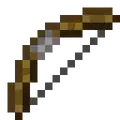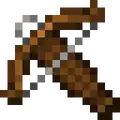Weapon
Weapons are items used to deal damage to entities. They include tools, projectiles, obstacles, and traps. Some weapons can be enchanted to enhance their combat efficacy.
Overview
Melee weapons can be held in the main hand while pressing the attack control to deal more damage than punching.
Ranged weapons can be used to fire projectiles.
- A bow or crossbow is a tool that uses arrow items (or requires 1 arrow if it has Infinity) and fires them as projectiles.
- Eggs, snowballs, splash potions, lingering potions, and wind charges can be fired directly by using them.
- Fire charges (fired by dispensers) and wind charges (fired directly) are special "hurting" projectiles, which move in a straight line and aren't affected by gravity.
Block weapons are typically used by placing them. A redstone circuit can be used in various ways, depending on its design.
Melee weapons
Melee weapons can be used to deal damage within a player's reach distance. A player can attack with the held weapon by pressing the attack control. In Java Edition, the damage dealt by melee weapons is affected by the attack cooldown: in order to deal maximum damage again, the player must wait for the weapon to "recharge" after each attack.
 Swords are the only weapon to get access to Looting, Knockback, and Sweeping Edge. In Java Edition, all swords have a cooldown time of 0.6 seconds (40% faster than golden, diamond, and netherite axes), are the only weapon type that can do sweep attacks to hit multiple targets, and have high damage per second. In Bedrock Edition, they deal more damage than any other melee weapon except for tridents, and have no attack cooldown.
Swords are the only weapon to get access to Looting, Knockback, and Sweeping Edge. In Java Edition, all swords have a cooldown time of 0.6 seconds (40% faster than golden, diamond, and netherite axes), are the only weapon type that can do sweep attacks to hit multiple targets, and have high damage per second. In Bedrock Edition, they deal more damage than any other melee weapon except for tridents, and have no attack cooldown.
 Axes are the only weapon that can disable a player's shield. In Java Edition, they deal more damage per hit than their sword counterparts, but have a slower cooldown. Wooden and stone axes have a cooldown time of 1.2 seconds, 80% slower than swords. Iron axes have a cooldown time of 1.1 seconds, 70% slower than swords. Golden, diamond, and netherite axes have a cooldown time of 1 second, 40% slower than swords. In Bedrock Edition, axes deal 1HP less damage than their sword counterparts, and have no attack cooldown.
Axes are the only weapon that can disable a player's shield. In Java Edition, they deal more damage per hit than their sword counterparts, but have a slower cooldown. Wooden and stone axes have a cooldown time of 1.2 seconds, 80% slower than swords. Iron axes have a cooldown time of 1.1 seconds, 70% slower than swords. Golden, diamond, and netherite axes have a cooldown time of 1 second, 40% slower than swords. In Bedrock Edition, axes deal 1HP less damage than their sword counterparts, and have no attack cooldown.
 Tridents can be swung to deal 9HP damage, the same as an unenchanted stone, iron, or diamond axe in Java Edition, or as an unenchanted netherite sword in Bedrock Edition. In Java Edition, their attack speed is 10% faster than golden, diamond, and netherite axes, being 0.9 seconds. Tridents cannot be crafted, and have to be obtained from defeating certain drowned, who also wield tridents, or through vaults in trial chambers.
Tridents can be swung to deal 9HP damage, the same as an unenchanted stone, iron, or diamond axe in Java Edition, or as an unenchanted netherite sword in Bedrock Edition. In Java Edition, their attack speed is 10% faster than golden, diamond, and netherite axes, being 0.9 seconds. Tridents cannot be crafted, and have to be obtained from defeating certain drowned, who also wield tridents, or through vaults in trial chambers.
 Maces deal 6HP base damage and, in Java Edition, have a cooldown time of 1.67 seconds, slower than wooden and stone axes and the slowest in the game. Maces can perform smash attacks that increase damage output depending on distance fallen before attacking. Successfully performing a smash attack will remove any fall damage accumulated prior to the attack. They can be crafted using a breeze rod and a heavy core.
Maces deal 6HP base damage and, in Java Edition, have a cooldown time of 1.67 seconds, slower than wooden and stone axes and the slowest in the game. Maces can perform smash attacks that increase damage output depending on distance fallen before attacking. Successfully performing a smash attack will remove any fall damage accumulated prior to the attack. They can be crafted using a breeze rod and a heavy core.
- Other tools, pickaxes, shovels, and hoes can be used as weapons, but they are not as effective as other melee weapons due to poor stats and a lack of access to weapon enchantments.
- Swords, tridents, and maces lose one durability point when used as weapons, while axes, pickaxes, shovels, and hoes lose two.
Ranged weapons
Ranged weapons are less effective in close combat and more effective at attacking enemies from a distance.
 Bows are the most common ranged weapon, used to shoot arrows at enemies to deal damage. Bows can be charged by pressing the use control: arrows go the farthest and deal the most damage when shot from a fully charged bow. Bows can be crafted using sticks and string, but are also a rare drop from skeletons and strays.
Bows are the most common ranged weapon, used to shoot arrows at enemies to deal damage. Bows can be charged by pressing the use control: arrows go the farthest and deal the most damage when shot from a fully charged bow. Bows can be crafted using sticks and string, but are also a rare drop from skeletons and strays.
 Crossbows have a longer range than bows, and deal more damage, but take longer to charge when unenchanted. The charging time can be drastically reduced with the Quick Charge enchantment to charge far faster than a bow. They can also shoot firework rockets to deal splash damage, but unlike the bow, crossbows cannot fire a partially charged attack; the player must fully charge a crossbow to load it and fire. Furthermore, a crossbow can be charged and put away to be fired later. Crossbows use triple durability when firing firework rockets, and also when fired while enchanted with Multishot. They can be crafted using sticks, string, iron ingots, and tripwire hooks, but can also be dropped from pillagers and certain piglins.
Crossbows have a longer range than bows, and deal more damage, but take longer to charge when unenchanted. The charging time can be drastically reduced with the Quick Charge enchantment to charge far faster than a bow. They can also shoot firework rockets to deal splash damage, but unlike the bow, crossbows cannot fire a partially charged attack; the player must fully charge a crossbow to load it and fire. Furthermore, a crossbow can be charged and put away to be fired later. Crossbows use triple durability when firing firework rockets, and also when fired while enchanted with Multishot. They can be crafted using sticks, string, iron ingots, and tripwire hooks, but can also be dropped from pillagers and certain piglins.
 Tridents can also be thrown to deal 8HP damage, the same as an unenchanted netherite sword. Unlike most other projectiles, they are not slowed down in water. A thrown trident must be retrieved, unless enchanted with Loyalty.
Tridents can also be thrown to deal 8HP damage, the same as an unenchanted netherite sword. Unlike most other projectiles, they are not slowed down in water. A thrown trident must be retrieved, unless enchanted with Loyalty.
 Fire charges cannot be launched by a player, but can be fired as small fireballs by a dispenser. When it hits an entity that is not immune to fire, a small fireball deals 5HP damage and sets the entity on fire for 4 seconds. When it lands on a block, it does not cause an explosion, but sets the block on fire if possible. It can also be used to prime TNT. Fire charges can be crafted using coal, blaze powder, and gunpowder.
Fire charges cannot be launched by a player, but can be fired as small fireballs by a dispenser. When it hits an entity that is not immune to fire, a small fireball deals 5HP damage and sets the entity on fire for 4 seconds. When it lands on a block, it does not cause an explosion, but sets the block on fire if possible. It can also be used to prime TNT. Fire charges can be crafted using coal, blaze powder, and gunpowder.
 Splash potions,
Splash potions,  lingering potions, or
lingering potions, or  tipped arrows of Instant Damage or Poison can be effectively used to damage enemies. Other effects like Weakness, Slowness, and Slow Falling can be used to significantly hinder an opponent in a fight. Splash potions can be obtained by brewing regular potions with gunpowder, lingering potions can be obtained by brewing splash potions with dragon's breath, and tipped arrows can be obtained by crafting arrows with lingering potions, or, in Bedrock Edition, by tipping arrows in a potion-filled cauldron.
tipped arrows of Instant Damage or Poison can be effectively used to damage enemies. Other effects like Weakness, Slowness, and Slow Falling can be used to significantly hinder an opponent in a fight. Splash potions can be obtained by brewing regular potions with gunpowder, lingering potions can be obtained by brewing splash potions with dragon's breath, and tipped arrows can be obtained by crafting arrows with lingering potions, or, in Bedrock Edition, by tipping arrows in a potion-filled cauldron.
- Throwable items
- knockback in Bedrock Edition.
- Cause durability damage to armor.
- Unlike a bow, these can be thrown quickly.
 Eggs
Eggs
- Has the same chance to spawn a chicken when used as a weapon, regardless of which entity it hits.
 Snowballs
Snowballs
- Thrown by snow golems as their only defense mechanism.
- Deals 3HP damage to a blaze.
 Wind charges deal 1HP on contact with a mob and heavy knockback to nearby entities. They can also interact with certain redstone components. Wind charges can be obtained as a product of grinding breeze rods in a crafting table.
Wind charges deal 1HP on contact with a mob and heavy knockback to nearby entities. They can also interact with certain redstone components. Wind charges can be obtained as a product of grinding breeze rods in a crafting table.
 TNT can be used to launch other TNT, making it a ranged weapon that requires some setup.
TNT can be used to launch other TNT, making it a ranged weapon that requires some setup.
Other weapons
Other items listed below can be used as weapons but usually have other intended uses and should be used strategically.
 TNT is capable of causing a large explosion when lit using fire, but has a long delay before the explosion, so it must be timed well to be used properly.
TNT is capable of causing a large explosion when lit using fire, but has a long delay before the explosion, so it must be timed well to be used properly.
 End crystals,
End crystals,  respawn anchors, and
respawn anchors, and  beds are capable of causing massive explosions, but are also very situational. Beds and respawn anchors only explode when used in the wrong dimension (anywhere except the Overworld and Nether, respectively). End crystals can only be placed on obsidian or bedrock. Beds and respawn anchors mainly allow the player to respawn at their positions in their respective dimensions, and end crystals can also be used to resurrect the ender dragon, as well as being used by it to regenerate health for itself.
beds are capable of causing massive explosions, but are also very situational. Beds and respawn anchors only explode when used in the wrong dimension (anywhere except the Overworld and Nether, respectively). End crystals can only be placed on obsidian or bedrock. Beds and respawn anchors mainly allow the player to respawn at their positions in their respective dimensions, and end crystals can also be used to resurrect the ender dragon, as well as being used by it to regenerate health for itself.
 Flint and steel and
Flint and steel and  fire charges can light fires, which can be used to deal great amounts of damage. Most mobs native to the Nether are immune to this.
fire charges can light fires, which can be used to deal great amounts of damage. Most mobs native to the Nether are immune to this.
 Lava buckets can be used to place lava, which deals great amounts of fire damage and slows down entities inside it, rendering it one of the most powerful weapons in an arsenal. Most mobs native to the Nether are immune to this.
Lava buckets can be used to place lava, which deals great amounts of fire damage and slows down entities inside it, rendering it one of the most powerful weapons in an arsenal. Most mobs native to the Nether are immune to this.
 Redstone traps can be used to kill the entity with all sorts of environmental damage, ranging from fall damage to suffocation to anything in between, but these must be prepared beforehand, so they oftentimes cannot be used in conventional combat.
Redstone traps can be used to kill the entity with all sorts of environmental damage, ranging from fall damage to suffocation to anything in between, but these must be prepared beforehand, so they oftentimes cannot be used in conventional combat.
 Anvils can deal massive damage to entities they fall onto, and also deal heavy damage to helmets regardless of if they land a lethal hit. However, these must be prepared beforehand, so they are more useful as traps than weapons. They also take damage when they land, so they can only be used as weapons a limited amount of times, so they must be used sparingly. Anvils are mainly used as repair stations that can also combine enchantments.
Anvils can deal massive damage to entities they fall onto, and also deal heavy damage to helmets regardless of if they land a lethal hit. However, these must be prepared beforehand, so they are more useful as traps than weapons. They also take damage when they land, so they can only be used as weapons a limited amount of times, so they must be used sparingly. Anvils are mainly used as repair stations that can also combine enchantments.
 Pointed dripstone can be dropped onto an entity like an anvil to deal damage, and can also deal double fall damage if an entity falls onto it.
Pointed dripstone can be dropped onto an entity like an anvil to deal damage, and can also deal double fall damage if an entity falls onto it.
 Cobwebs greatly slow all entities inside them, which can be used strategically to gain a massive advantage. They do not, however, do anything to arthropods.
Cobwebs greatly slow all entities inside them, which can be used strategically to gain a massive advantage. They do not, however, do anything to arthropods.
- Some blocks cause damage on contact, and can be used as obstacles to hinder mobs and other players. These include cacti, sweet berry bushes, wither roses (if target is not immune to Wither), campfires (if target is not immune to fire), and magma blocks (if the target isn't sneaking, wearing Frost Walker boots, or is immune to fire).
- Hostile mobs can also be used as weapons, especially since some mobs can be manipulated easily. However, these mobs tend to attack any player without provocation, and there are also certain groups of mobs that do not attack each other even if provoked. Great care must be taken if hostile mobs are to be used as weapons.
Issues
Issues relating to "Weapon" are maintained on the bug tracker. Issues should be reported and viewed there.
Gallery
Renders
Melee
-
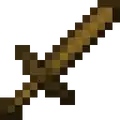 A wooden sword.
A wooden sword. -
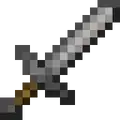 A stone sword.
A stone sword. -
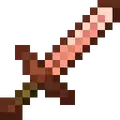 A copper sword.
A copper sword. -
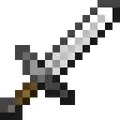 An iron sword.
An iron sword. -
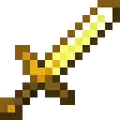 A golden sword.
A golden sword. -
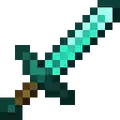
-
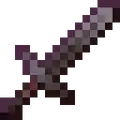
Ranged
Both
-
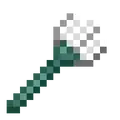 A trident.
A trident.
In other media
-
 Efe crafting a diamond sword, surrounded by other weapons.
Efe crafting a diamond sword, surrounded by other weapons. -
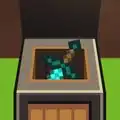 A chest with a sword in it.
A chest with a sword in it. -
 A ravager next to Alex with a diamond sword.
A ravager next to Alex with a diamond sword. -

